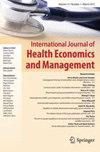摩洛哥灾难性和致贫卫生支出的发生率:新方法的附加值:来自2014年全国家庭生活水平调查的证据。
摘要
摩洛哥政府在实现全民健康覆盖方面的主要目标之一是改善家庭财务保护,防止灾难性卫生支出。然而,对于如何衡量CHE,目前还没有达成共识。此外,使用传统方法衡量CHE对公平分析和扶贫政策举措构成了挑战。因此,本文旨在进行深入的国家分析,让决策者了解财政困难的程度、分布和原因。此外,本研究旨在探讨摩洛哥不同的支付能力(CTP)计算方法对公平和政策的影响。我们使用不同的方法对灾难性和致贫性卫生支出发生率进行了估计。这些方法包括(i)预算份额法(BS方法),(ii)部分规范食品支出法(规范食品方法),(iii) Wagstaff和Eozenou方法(WAE方法),以及(iv)规范食品,住房(租金)和公用事业(FHU)方法(世卫组织欧元方法)。数据来自2014年摩洛哥全国家庭消费和支出调查(NHCES)。为了衡量四种计算方法之间财务保护的变化,我们还使用加权财务保护指数(FP指数)和另一个衡量财务贡献公平性的指数(FFC)。使用世卫组织EURO方法和BS方法估算的CHE发病率在家庭CTP的15%阈值上相似。当使用食物贫困线(food - pl)时,自付贫困率估计为1.31%,当使用FHU贫困线(FHU- pl)时,自付贫困率估计为1.93%。此外,利用FOOD-PL和FHU-PL估算的进一步贫困化OOP分别为3.39%和5.41%。研究表明,与新方法不同,传统方法高估了富裕阶层的经济负担。BS方法表明摩洛哥卫生系统是平等主义的,而新方法表明它符合规范的公平目标。计划生育指数和FFC随着贫困线的提高而下降。医药是经济困难的第一个驱动因素。补偿OOP造成的贫困所需的货币转移分别为每人每年141迪拉姆和269迪拉姆(按FOOD-PL和FHU-PL计算)。结果表明,应审查医疗保险制度,以进一步减少摩洛哥的CHE和贫困化。使用BS方法跟踪可持续发展目标的具体目标3.8.2,引发了对可持续发展目标进程能否就全民健康覆盖提供适当政策指导的担忧。使用不同方法的研究。比如这个。预期将促进知情决策,并防止在表明一项政策的成功或失败时潜在的政治操纵。•我们的研究评估了估算摩洛哥CHE的不同CTP方法对公平的影响。•传统方法系统性地夸大了富裕家庭的经济负担。•世卫组织EURO方法提供了最准确的评估,既捕获了CHE发病率的回归性质,又捕获了OOP/CTP的渐进模式。•调查结果强调了摩洛哥正在进行的卫生筹资改革的重要性,以减少自付费用。•未来的研究应纳入放弃的照顾和应对策略,以加强财务保护分析。One of the key objectives of the Moroccan government in achieving universal health coverage (UHC) in Morocco is to improve household financial protection against catastrophic health expenditure (CHE). However, there is no consensus on how to measure CHE. Moreover, measuring CHE using traditional methods poses a challenge for equity analysis and pro-poor policy initiatives. Therefore, this paper aims to conduct an in-depth national analysis to inform policymakers about the extent, distribution and causes of financial hardship. In addition, this study aimed to explore the equity and policy implications of different capacity-to-pay (CTP) methodologies for calculating CHE in Morocco. We present estimates of catastrophic and impoverishing health spending incidence using different methods. These methods include (i) the budget share method (BS method), (ii) the partial normative food expenditure method (Normative food method), (iii) Wagstaff and Eozenou's approach (WAE approach), and (iv) the normative food, housing (rent), and utilities (FHU) method (WHO EURO method). The data comes from the 2014 Moroccan National Household Consumption and Expenditure Survey (NHCES). To measure changes in financial protection between the four calculation methods, we also use a weighted financial protection index (FP index) and another index measuring the fairness of financial contributions (FFC). CHE incidence estimates were similar using the WHO EURO method and the BS method at the threshold of 15% of a household's CTP. The estimate of impoverishing out-of-pocket payments (OOP) was 1.31% when using the food poverty line (FOOD-PL) and 1.93% when using the FHU poverty line (FHU-PL). In addition, the further impoverishing OOP estimate was 3.39% and 5.41% using the FOOD-PL and FHU-PL, respectively. The study shows that, unlike the new methods, conventional methods overestimate the financial burden of the better-off. The BS method suggests that the Moroccan health system is egalitarian, while the new approaches suggest that it meets normative equity objectives. The FP index and the FFC decrease as the poverty line rises. Medicine is the first driver of financial hardship. The monetary transfer needed to compensate for the impoverishment caused by OOP is about 141 MAD and 269 MAD per person per year, using FOOD-PL and FHU-PL, respectively. The results suggest that the health insurance system should be reviewed to further reduce CHE and impoverishment in Morocco. The use of the BS method to track target 3.8.2 of the SDGs raises concerns about the ability of the SDG process to generate appropriate policy guidance on UHC. Studies using different approaches. such as this one. are expected to facilitate informed decision-making and prevent potential political manipulation in demonstrating the success or failure of a policy. HIGHLIGHTS: • Our study evaluates the equity implications of different CTP methods for estimating CHE in Morocco. • Traditional methods systematically overstate the financial burden on wealthier households. • The WHO EURO methodology provides the most accurate assessment, capturing both the regressive nature of CHE incidence and the progressive pattern of OOP/CTP. • Findings reinforce the importance of Morocco's ongoing health financing reforms to reduce out-of-pocket payments. • Future research should incorporate forgone care and coping strategies to enhance financial protection analysis.

 求助内容:
求助内容: 应助结果提醒方式:
应助结果提醒方式:


